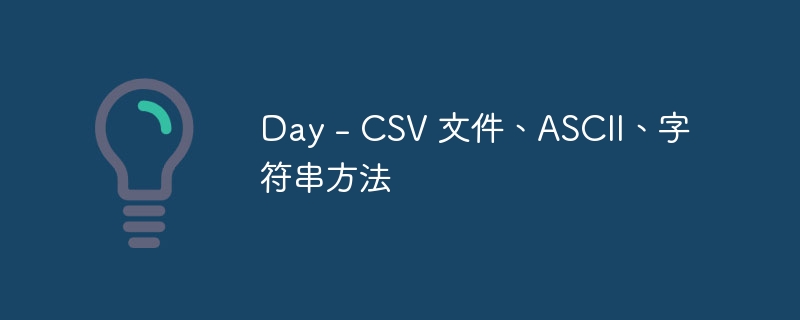Day - CSV 文件、ASCII、字符串方法
来源:dev.to
时间:2024-12-19 13:46:07 332浏览 收藏
文章小白一枚,正在不断学习积累知识,现将学习到的知识记录一下,也是将我的所得分享给大家!而今天这篇文章《Day - CSV 文件、ASCII、字符串方法》带大家来了解一下##content_title##,希望对大家的知识积累有所帮助,从而弥补自己的不足,助力实战开发!

csv(逗号分隔值):
csv 文件代表一行,行内的每个值都用逗号分隔。
csv 文件看起来像 excel,但 excel 文件只能在 excel 软件中打开。
csv 文件用于所有操作系统。
我们可以打开以下两种格式的csv文件。
f =open("sample.txt", "r")
with open("sample.txt",’r’) as f:
r-读
打开文件进行读取。文件必须存在。
w-写
打开文件进行写入。创建一个新文件或覆盖现有文件。
rb-读取二进制
这用于读取二进制文件,如图像、视频、音频文件、pdf 或任何非文本文件。
store.csv
player,score virat,80 rohit,90 dhoni,100
import csv
f =open("score.csv", "r")
csv_reader = csv.reader(f)
for row in csv_reader:
print(row)
f.close()
['player', 'score'] ['virat', '80'] ['rohit', '90'] ['dhoni', '100']
ascii:
ascii 代表美国信息交换标准代码。
ascii 表:
48-57 - 数字(数字 0 到 9)
65-90 - a-z(大写字母)
97-122 - a-z(小写字母)
使用 ascii 表的模式程序:
for row in range(5):
for col in range(row+1):
print(chr(col+65), end=' ')
print()
a a b a b c a b c d a b c d e
for row in range(5):
for col in range(5-row):
print(chr(row+65), end=' ')
print()
a a a a a b b b b c c c d d e
使用 for 循环:
name = 'pritha'
for letter in name:
print(letter,end=' ')
p r i t h a
使用 while 循环:
name = 'pritha'
i=0
while i<len(name):
print(name[i],end=' ')
i+=1
p r i t h a
字符串方法:
1.大写()
python中的capitalize()方法用于将字符串的第一个字符转换为大写,并将所有其他字符转换为小写。
txt = "hello, and welcome to my world." x = txt.capitalize() print (x)
hello, and welcome to my world.
使用 ascii 表编写大小写程序:
txt = "hello, and welcome to my world."
first = txt[0]
first = ord(first)-32
first = chr(first)
print(f'{first}{txt[1:]}')
hello, and welcome to my world.
2.casefold()
python 中的 casefold() 方法用于将字符串转换为小写。
txt = "hello, and welcome to my world!" x = txt.casefold() print(x)
hello, and welcome to my world!
使用 ascii 表编写一个折页程序:
txt = "hello, and welcome to my world!"
for letter in txt:
if letter>='a' and letter<'z':
letter = ord(letter)+32
letter = chr(letter)
print(letter,end='')
hello, and welcome to my world!
3.count()
python 中的 count() 方法用于统计字符串中子字符串的出现次数。
txt = "i love apples, apple is my favorite fruit"
x = txt.count("apple")
print(x)
2
为给定的键编写一个计数程序:
txt = "i love apples, apple is my favorite fruit"
key="apple"
l=len(key)
count=0
start=0
end=l
while end<len(txt):
if txt[start:end]==key:
count+=1
start+=1
end+=1
else:
print(count)
2
编写一个程序来查找给定键的第一次出现:
txt = "i love apples, apple is my favorite fruit"
key="apple"
l=len(key)
start=0
end=l
while end<len(txt):
if txt[start:end]==key:
print(start)
break
start+=1
end+=1
7
编写一个程序来最后一次出现给定的键:
txt = "i love apples, apple is my favorite fruit"
key="apple"
l=len(key)
start=0
end=l
final=0
while end<len(txt):
if txt[start:end]==key:
final=start
start+=1
end+=1
else:
print(final)
15
任务:
for row in range(4):
for col in range(7-(row*2)):
print((col+1),end=" ")
print()
1 2 3 4 5 6 7 1 2 3 4 5 1 2 3 1
for row in range(5):
for col in range(5-row):
print((row+1)+(col*2),end=" ")
print()
1 3 5 7 9 2 4 6 8 3 5 7 4 6 5
好了,本文到此结束,带大家了解了《Day - CSV 文件、ASCII、字符串方法》,希望本文对你有所帮助!关注golang学习网公众号,给大家分享更多文章知识!
-
501 收藏
-
501 收藏
-
501 收藏
-
501 收藏
-
501 收藏
-
300 收藏
-
212 收藏
-
160 收藏
-
321 收藏
-
133 收藏
-
399 收藏
-
280 收藏
-
349 收藏
-
143 收藏
-
287 收藏
-
377 收藏
-
274 收藏
-

- 前端进阶之JavaScript设计模式
- 设计模式是开发人员在软件开发过程中面临一般问题时的解决方案,代表了最佳的实践。本课程的主打内容包括JS常见设计模式以及具体应用场景,打造一站式知识长龙服务,适合有JS基础的同学学习。
- 立即学习 543次学习
-

- GO语言核心编程课程
- 本课程采用真实案例,全面具体可落地,从理论到实践,一步一步将GO核心编程技术、编程思想、底层实现融会贯通,使学习者贴近时代脉搏,做IT互联网时代的弄潮儿。
- 立即学习 516次学习
-

- 简单聊聊mysql8与网络通信
- 如有问题加微信:Le-studyg;在课程中,我们将首先介绍MySQL8的新特性,包括性能优化、安全增强、新数据类型等,帮助学生快速熟悉MySQL8的最新功能。接着,我们将深入解析MySQL的网络通信机制,包括协议、连接管理、数据传输等,让
- 立即学习 500次学习
-

- JavaScript正则表达式基础与实战
- 在任何一门编程语言中,正则表达式,都是一项重要的知识,它提供了高效的字符串匹配与捕获机制,可以极大的简化程序设计。
- 立即学习 487次学习
-

- 从零制作响应式网站—Grid布局
- 本系列教程将展示从零制作一个假想的网络科技公司官网,分为导航,轮播,关于我们,成功案例,服务流程,团队介绍,数据部分,公司动态,底部信息等内容区块。网站整体采用CSSGrid布局,支持响应式,有流畅过渡和展现动画。
- 立即学习 485次学习
